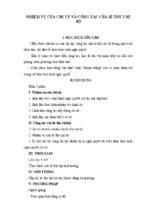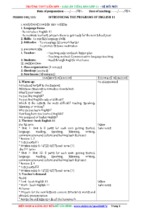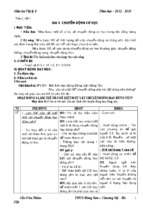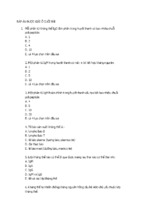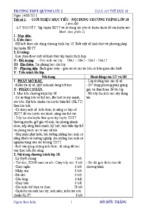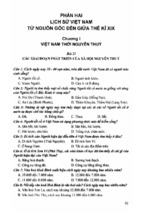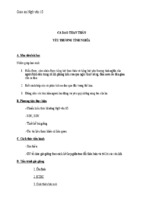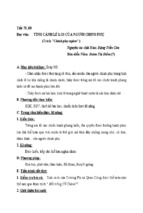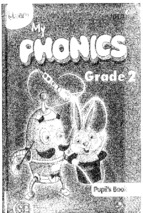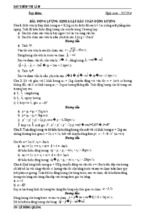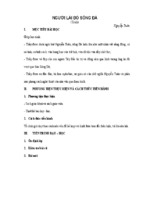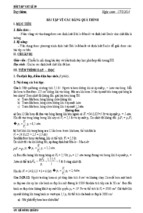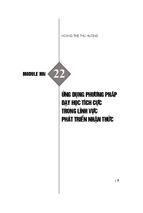CHƯƠNG TRÌNH & SGK TIẾẾNG ANH - HỆ ĐỔI MỚI - GIÁO ÁN GIẢNG DẠY KHỐẾI 12 - HKII
Date of preparation: 01/ 01/ 2019
Date of Teaching: 05/ 01/ 2019
TIẾẾT 55:
UNIT 6. ENDANGERED SPECIES
LESSON 1. GETTING STARTED
A. Objectives:
1. Language focus: - The topic of Unit 6: “Endangered species”, to Endangered species.
- To check students’ comprehension thorough questions and answers
- To help learners get started with some language items in Unit 6
2. Skills:
- To help learners get started with 4 skills in Unit 6.
- Reading: Reading for general ideas and specific information.
- Speaking: Talking about how to protect endangered species.
- Listening: Listening for specific information.
- Writing: Writing a report about endangered species.
3. Attitudes: - To help Ss get started for Unit 6 with the topic "Endangered species"
- To provide Ss some motivation
B. Preparations:
- Teacher: Handouts, textbook, lesson plan, papers and cassette.
- Students: Textbook
C. Methods:
- The whole lesson: Integrated, mainly communicative.
D. Procedures:
Time/Stages
Activities
Interactions
- Look at the pictures and name the animals
1. Warm up
- T shows the pictures and has Ss name the animals.
5 minutes
T <--> Ss
- T asks Ss the questions to elicit the new lesson.
Activity 1: Listen and read
2. New lesson
- T. plays the recording, asks Ss to listen and read silently.
17 minutes
T <--> Ss
- Ss listen and read silently.
- T. tells Ss that they are going to listen to a conversation
Whole class
between Mr. Willis, Simon and Lisa.
Activity 2: Decide whether the statements are True, False or Not
Individually
Given.
- Ask Ss to read the statements individually first.
- Encourage Ss to provide reasons for their answers.
- T gives feedback.
10 minutes
Key: 1.T 2.F 3.NG 4.T 5.T 6.F
Activity 3: Find a word in the conversation to complete each of
the following phrases/ expressions.
- Sts are asked to do this exercise individually.
T <--> Ss
- Ask Ss to read the incomplete phrases.
- T gives feedback.
Key: 1. Extinct 2. Extinction 3. Endangered 4. Build
10 minutes
Activity 4: Read the conversation again and write the correct Individually
or
forms of the verbs in brackets
Pair work
- Sts do this exercise individually and then compare their
answers with their partners.
T <--> Ss
- Ask Ss to read the conversation again and write the correct
form for the given verbs in the space provided.
- T gives feedback and introduces the Future Perfect.
Key: 1. Will have gathered 2. Will have walked
3.
- Ask Ss: What have you learnt today? What can you do now?
Consolidation - Summarize the main points of the lesson.
T <--> Ss
2 minutes
4. Homework
- Ask Ss to learn by heart the words or phrases related to the
1 minute
topic
T <--> Ss
- Prepare for the next lesson.
Trang 1
CHƯƠNG TRÌNH & SGK TIẾẾNG ANH - HỆ ĐỔI MỚI - GIÁO ÁN GIẢNG DẠY KHỐẾI 12 - HKII
Date of preparation: 02/ 01/ 2019
Date of Teaching: 08/01/ 2019
TIẾẾT 56:
UNIT 6. ENDANGERED SPECIES
LESSON 2. LANGUAGE
A. Aims and Objectives:
1. Language focus: - To provide learners some language items in Unit 6
- For vocabulary, that is words and phrases related to Endangered species.
- For pronunciation, that is the linking vowel to vowel in connected speech
- For grammar, that is the future perfect vs. double comparatives.
2. Skills:
To promote Ss to develop the skill of working in pairs and groups
3. Attitudes:
To encourage Ss to work harder. To provide Ss some motivation
B. Preparations: - Teacher: Handouts, textbook, pieces of papers, lesson plan and cassette.
- Students: Textbook
C. Methods:
The whole lesson: Integrated, mainly communicative.
D. Procedures:
Time/Stages
Activities
1. Homework
- T spells some words, asking Ss to try to recognize them
- Ss try to recognize them
3 minutes
- T. asks Ss to read the context provided to do the task.
- T asks Ss to do exercises on workbook.
2. New lesson
A. Vocabulary:
Activity 1: Complete the following word diagrams
7 minutes
- T asks students to match the words with their meanings.
- T checks answers as a class.
Key: 1. Extinction
2. Dangerous, endanger 3. Survival
4. Diversity, diversify 5. Evolution.
Activity 2: Complete the sentences with the correct forms of the words in the
box.
- Sts do as required, bearing in mind a verb or a noun.
- T asks Ss to complete the sentences individually. Alternatively, in a weaker
class, T has Ss work on the sentences in pairs.
- Sts find the suitable words to fill in the gaps.
- T checks answers as a class.
Key: 1. Evolution, survival
2. Endangered 3. Habitat
4. vulnerable
5. Extinct 6. Biodiversity 7. Conservation
B. Pronunciation: Linking vowel to vowel
Activity 1. The following phrases are spoken in low, careful speech and in fast,
connected speech. Listen and repeat. Pay attention to the pronunciation of the
linked sounds
- T tells students that they are going to listen to six phrases spoken in two
7 minutes
different ways: slow, careful speech
- T asks students to listen and repeat - Ss repeat chorally and individually.
Activity 2: Listen and repeat the following sentences spoken in fast,
connected speech
- T plays the recording for Ss to repeat chorally and individually.
- Ss listen and repeat the following sentences, paying attention to the linking.
C. Grammar: The future perfect
Activity 1: Circle the correct verb form in each sentence
-T has students review the uses of the future perfect.
-T asks students to study the remember box.
-T asks students to read each sentence carefully
Key: 1. Will have released 2. Has lived 3. Will have finished
4. will be watching / will have finished 5. Won’t have completed
12 minutes
Activity 2: Complete the sentences using the Present Perfect or the Future
Perfect.
- Ask Ss to read each sentence carefully, paying attention to the context and
Trang
CHƯƠNG TRÌNH & SGK TIẾẾNG ANH - HỆ ĐỔI MỚI - GIÁO ÁN GIẢNG DẠY KHỐẾI 12 HKII
the time expressions.
- T has students do the activity individually first, and then compare the
answers in pains. T checks answers as a class.
Key: 1. Will have saved and taken in
2. Has lived
3. will have finished
4. Will have visited 5. Have collected
Double comparatives
Structures:
1. The+ comparative adj/adv+ S+V, the+ comparative adj/adv+ S+V
2. The + more/less+ ( noun)+ S+V, the + more/less+ ( noun)+ S+V
Activity 3: Discuss which words in the box can be used in each gap.
- Ask Ss to work in pairs and to suggest which word can be used in each gap.
- T checks answers as a class.
13 minutes
Key: 1. more/ longer, better/ higher
2. more, better
Activity 4: Complete the sentences with the words from the box.
- Ask Ss to work in pairs and to suggest which word can be used in each gap. - T
checks answers as a class.
Key: 1. higher/ more 2. more/ more
3. warmer/ faster
4. more/ greater
5. More/ better
3.
- Ask Ss: What have you learnt today? What can you do now?
Consolidation - Summarize the main points of the lesson.
2 minutes
Expected answers: I can use: Assimilation in connected speech
The present perfect and present perfect continuous
- T asks Ss to do exercises again at home.
4. Homework
- Prepare for the next lesson. - Complete Exercises in workbook.
1 minute
E. Evaluation:
..........................................................................................................................................................................................................
Date of preparation: 03/ 01/ 2019
TIẾẾT 57:
Date of Teaching: 09/01/ 2019
UNIT 6. ENDANGERED SPECIES
LESSON 3. READING
A. Aims and Objectives: - To scan a text for specific information in a passage.
- To teach Ss new vocabulary by answering questions.
- To develop their reading skill through choosing the main idea for each paragraph.
- To learn new vocabulary by finding words or expressions with the meanings given.
B. Preparations: - Teacher: Handouts, textbook, pieces of papers, lesson plan and cassette.
- Students: Textbook
C. Methods:
- The whole lesson: Integrated, mainly communicative.
D. Procedures:
Time/Stages
Activities
Interactions
1. Lead-in 8
Skimming and scanning an article for general ideas and specific
minutes
information, and learning additional vocabulary and T <--> Ss
information related to the endangered species
Ss work in pairs, look at the vocabulary items in the word bank
and discuss their meanings.
Saving endangered species: pros and cons
2. New lesson
Activity 1: Look at the pictures again and discuss the two
17 minutes
Pair work
questions:
- T has sts discuss the questions in pairs.
- T elicits the new lesson. T checks answers as a class.
Key: 1. Tigers, saolas, elephants, sea turtles, and giant pandas
T <--> Ss
on the list of endangered species.
2. Tigers, saolas, elephants and sea turtles are still found in Viet
Pair work
Nam, but each with a small population.
Activity 2: Read the passage again and find out what they are
Trang 3
12 minutes
5 minutes
talking about.
-T tells to read three people’s opinions posted on a website.
-To read the opinions and decide what writers are discussing.
-T checks answers as a class.
Key: c
Activity 3: Whose opinions are these? Write the correct name in
the space before each statement.
- Provide guidance on how to approach this kind of activity to
find ideas, words or phrases that match the key words in the
statements.
- T has students work in pairs and compare the answers.
Key: 1. Yoshiko 2. Ai Lien 3. Simon 4. Yoshiko 5. Simon 6. Ai
Lien
Activity 4: Find the prepositions in the reading text to
complete these phrases.
- Have Ss read the text again and find the prepositions to
complete the phrases and expressions.
-T checks answers as a class.
Key: 1. In 2. To 3. To 4. With 5. At
T <--> Ss
Individually/
Pair work
T <--> Ss
3.
Consolidation - Summarize the main points of the lesson
T <--> Ss
2 minutes
- Ask students to learn by heart the new words.
4. Homework
- Prepare for the next lesson.
T <--> Ss
1 minute
E. Evaluation:
..........................................................................................................................................................................................................
Date of preparation: 04/01/ 2019
TIẾẾT 58:
Date of Teaching: 11/ 01/ 2019
UNIT 6. ENDANGERED SPECIES
LESSON 4. SPEAKING
A. Aims and Objectives: - To talk about a chance to discuss lifestyle choices.
- To teach Ss to practise sharing and giving responses to new information.
- By the end of the lesson, students will be able to:
+ Express their opinion about some activities that can help discuss lifestyle choices.
+ Perform their viewpoints to other people in real life.
B. Preparations:
- Teacher: Handouts, textbook, lesson plan and pieces of papers.
- Students: Textbook
C. Methods:
- The whole lesson: Integrated, mainly communicative.
D. Procedures:
Time/Stages
Activities
Interactions
- T asks Ss some questions:
1. Warm up
+ Are soot emissions a problem in your community or in
8 minutes
Vietnam in general? Explain. + Do you have a green lifestyle?
T <--> Ss
+ Tell one green activity you have done.
- T elicits answers from students about how green they are.
2. New lesson
Action for endangered species conservation
Activity 1: Put the following ways of protecting rhinos and coral
10 minutes
reefs in the correct boxes
Individually
-T asks students to work individually.
- Eight ways of protecting the two endangered species.
-T encourages students to add more activities.
- Explain the new words if necessary.
11 minutes
Key: How to protect rhinos
T <--> Ss
- ban transportation of and trading in rhinos in horns
13 minutes
- donate to rhino conservation
- launch anti-poaching campaigns.
Pair work
- stop using rhino products
Activity 2: Work in pairs. Use the information in 1 or your own
ideas to prepare a talk about how to protect rhinos or coral
reefs.
- Work with a partner to read the information.
T <--> Ss
- T asks students to pay attention to phrases and expressions.
- To talk about how to protect rhinos or coral reefs.
- Have Ss practice giving their talk in pairs.
Activity 3: Present your talk to the class
-T asks students to present their talk in front of the class.
- Give feedback. Praise Ss who can give a smooth talk and use
the appropriate phrases and expressions.
- Summarize what they have learnt by asking Ss some
questions: What have you learnt today? What can you do now?
T <--> Ss
3.
Consolidation
2 minutes
- Ask students to learn by heart the expressions.
4.Homework
- Prepare for the next lesson.
T <--> Ss
1 minute
E. Evaluation:
..........................................................................................................................................................................................................
Date of preparation: 08/ 01/ 2019
TIẾẾT 59:
Date of Teaching: 15/ 01/ 2019
UNIT 6. ENDANGERED SPECIES
LESSON 5. LISTENING
A. Aims and Objectives: - Listening to for general ideas and specific information.
- Understand general ideas and specific details to answer comprehension questions.
- By the end of the lesson, students will be able to:
+ Listen and do the tasks.
+ Develop the listening skills for specific details.
+ Identify specific information through multiple-choice task and question answering
B. Preparations:
- Teacher: Handouts, textbook, pieces of papers and cassette.
- Students: Textbook
C. Methods:
- The whole lesson: Integrated, mainly communicative.
D. Procedures:
Time/Stages
Activities
Interactions
1. Lead-in 7
- Inform the class of the lesson objectives: listening for specific
minutes
information in a conversation between two students talking T <--> Ss
about why animals are in danger of extinction.
Dangers to wildlife
2. New lesson
Task 1: Below is the conservation status scale which indicates
whether a species still exists and how likely it is to become extinct Pair work
10 minutes
in the near future. Match the three phrases indicating three
“threatened” levels with the numbers 1, 2 and 3.
- T helps Ss to understand how endangered species are classified.
- T asks Ss which “threatened” level (1, 2, or 3) in the scale goes
with the phrases VU, CR or EN. T checks answers as a class.
T <--> Ss
Task 2: Listen and check the answers in 1.
- T checks student’s comprehension to make sure they are
13 minutes
familiar with the language.
Pair work
- Play the recording non-stop so students can get the gist.
Key: 1. CR
2 EN
3. VU
Task 3: Listen to the second part and choose the best option - T
12 minutes
tells students that the activity focuses on listening for general
ideas. Have them trade the question and make some guesses about
the content and the structure of the listening text.
- To make sure they are familiar with the language.
- Play the recording non-stop so students can get the gist.
Key: 1. B
2. C
3. A
4.C
Task 4: Listen to the second part again and complete the
summary
-T tells students that the activity focuses on listening for specific
information.
- Ask Ss to guess which word might go into each gap.
- Work in pairs checks their answers as a class.
Key: 1. endangered 2. habitat 3. poaching
4. human
5. conserve
- Ask Ss to consolidate the main contents.
- Ask Ss: What have you learnt today?
What can you do now?
T <--> Ss
Pair work
T <--> Ss
3.
Consolidation
T <--> Ss
2 minutes
4. Homework
- Prepare for the next lesson.
T <--> Ss
1 minute
E. Evaluation:
..........................................................................................................................................................................................................
Date of preparation: 09/ 01/ 2019
TIẾẾT 60:
Date of Teaching: 16/ 01/ 2019
UNIT 6. ENDANGERED SPECIES
LESSON 6. WRITING
A. Aims and Objectives: - To develop skill of writing a report about endangered species
- To provide Ss with the language and sentence structures used to describe trends.
- By the end of the lesson, students will be able to:
+ Learn about a report about endangered species.
+ Develop the writing skills in general. Build up vocabulary supported for writing.
B. Preparations:
- Teacher: Handouts, textbook, lesson plan and pieces of papers.
- Students: Textbook
C. Methods:
- The whole lesson: Integrated, mainly communicative.
D. Procedures:
Time/Stages
Activities
Interactions
1. Check up
The lesson objective: Writing a report about endangered
5 minutes
species.
T <--> Ss
Endangered species report
2. New lesson
Task 1: Match the pictures with the animals’ names, Then discuss
8 minutes
the questions with a partner.
Pair work
- T tells students to match the pictures with the animals’ names.
- Have Ss discuss the three questions with a partner.
- Allow all wild guesses at this stage.
Key: 1. b (Komodo dragon: not found in Viet Nam; eat meat;
T <--> Ss
classified as vulnerable)
2. a (blue whale: sometimes found stranded on Viet Nam’s
Individually
coastal areas; eat small shellfish; classified as endangered)
10 minutes
Task 2: Read the facts about the Komodo dragon and the blue or
whale. Write a, b, c, d or e in the space provided to match the title Pair work
with the correct section
- T tells students that they are going to read the facts about the
Komodo dragon and the blue whale. Allow enough time for them
T <--> Ss
to read through the facts.
-T asks students to match the subheadings with the five parts.
- T checks answers as a class.
Key: 1. c
2.e
3. a
4. d
5. b
14 minutes
Task 3: Choose one of the two species in 2 and write a report of Individually
150 – 200 words to describe it.
- To incorporate the feedback and write the first draft in full
sentences.
- To work independently and write their final essays.
T <--> Ss
- Ask question or say what they like most about writing.
- Collect some of the Ss’ final drafts and give written comments.
3.
- Ask Ss to consolidate the main contents.
Consolidation - Ask Ss to complete the writing at home and collect
T <--> Ss
- Ask Ss: What have you learnt today?
What can you do now?
2 minutes
- Write the text again at home.
4.Homework
- Prepare for the next lesson.
T <--> Ss
1 minute
E. Evaluation:
..........................................................................................................................................................................................................
Date of preparation: 10/ 01/ 2019
TIẾẾT 61:
Date of Teaching: 18/ 01/ 2019
UNIT 6. ENDANGERED SPECIES
LESSON 7. COMMUNICATION AND CULTURE
A. Aims and Objectives:
1. Language focus - To provide learners some communication samples, cultural items
2. Skills
- To develop communication skills and cultural understanding
- To help Ss develop the skill of working in pairs and groups
3. Attitudes:
- To encourage Ss to work harder, to provide Ss some motivation
- By the end of the lesson, students will be able to:
+ Communication skills and cultural understanding.
+ Talk about how sea turtles are protected in Malaysia.
B. Preparations:
- Teacher: Handouts, textbook, lesson plan and pieces of papers.
- Students: Textbook
C. Methods:
- The whole lesson: Integrated, mainly communicative.
D. Procedures:
Time/Stages
Activities
Interactions
1. Warm up
- Inform the class of the lesson objectives: Further skill
T <--> Ss
5 minutes
development
1. Communication: Bringing extinct species back to life?
2. New lesson
Activity 1: Listen to two exchanges.
17 minutes
- Tell students that they are going to listen to two exchanges
Pair work
and will have to understand the speakers’ opinions.
- Read the questions and underline the key words.
- Play the recording once or twice.
Key: Van: Yes (Well, why not?)
Nam: No (I’d say no to this idea)
Mary: Yes ( So I agree with them, not with you)
Paul: No (What a silly idea!)
Activity 2: Are you for against the revival of extinct species?
T <--> Ss
- Ask students to work with a partner to compare their
answers.
- Ask some pairs to report their opinions to the class.
- Check answers as a class.
Pair work
2. Culture: Let’s save the sea turtles!
20 minutes
Activity 1: Read the text about how sea turtles are protected
and complete the notes.
- T has students read the text quickly and complete the notes
- Work in pairs and discuss the information.
T <--> Ss
Key: 1. endangered, critically endangered
2. loss of nesting habitat 3. climate change
4. warm
5. the beach/ beaches
6. breeding ground
7. turtle eggs
8. raise public awareness
Group work
Activity 2: Discussing.
- Assign this activity as homework of the previous lesson
- T asks students to work in groups
T <--> Ss
- After their discuss, T asks some groups to report their
experiences and opinions to the class.
3.
- Ask Ss to consolidate the main contents.
Consolidation - Ask Ss: What have you learnt today?
T <--> Ss
What can you do now?
2 minutes
T
asks
Ss to learn the structures and vocabulary.
4.Homework
- Prepare for the next lesson.
T <--> Ss
1 minute
E. Evaluation:
..........................................................................................................................................................................................................
Date of preparation: 15/ 01/ 2019
TIẾẾT 62:
Date of Teaching: 22/ 01/ 2019
UNIT 6. ENDANGERED SPECIES
LESSON 8. LOOKING BACK AND PROJECT
A. Aims and Objectives: - To help Ss pronounce revise what they have learned in unit 6.
- To teach Ss some lexical items related to the endangered species.
- To give them a chance to do a small project, help Ss review and recognize the linking.
- To help Ss consolidate the use of the future perfect tense and double comparatives.
B. Preparations: - Teacher: Handouts, textbook, pieces of papers, lesson plan and cassette.
- Students: Textbook
C. Methods:
- The whole lesson: Integrated, mainly communicative.
D. Procedures:
Time/Stages
Activities
T informs the class the objectives: reviewing pronunciation, vocabulary and
1. Warm-up
grammar. T reviews from and use of the future perfect tense and double
5 minutes
comparatives.
Pronunciation:
2. New lesson
Activity 1: Read the following exchanges. Decide where the linking /r/ is
8 minutes
likely to happen in fast, fluent speech.
- T helps students to review the linking /r/
- T has students read the sentences and underline the sounds.
- T asks students to work with a partner to compare their answers. - T
checks answers as a class.
9 minutes
Activity 2: Listen and repeat the exchanges in 1
-T plays the recording and has students listen and repeat.
-T asks some students to say these sentences aloud.
Vocabulary:
Activity 1: Complete the sentences with the correct forms of the words in
brackets.
-T gives comments and praises students.
-T has students read the instructions and do the activity.
-T checks answers as a class.
Key: 1. survival
2. extinct
3. endangered
4. conservation
5. poaching
5. evolution
Grammar:
12 minutes
Activity 1: Practise asking questions and giving answers, using the prompts
-T asks students to read through the prompts and the form
-T has students do the activity individually.
-T checks answers as a class.
Key: 1. How long will you have studied English in this school by the time
you graduate in June?
2. How long will you have lived in you present home by next year?
3. How many new English words will you have learnt by the end of this
unit?
Activity 2: Rewrite these sentences, using double comparatives.
-T tells students that they are going to write sentences about someone
called Andy.
-T asks students to read the situation and the example first.
- T checks answers as a class.
Key: 1. The more land people need to build houses, the more forests they
cut down.
2. The higher the unemployment rate gets, the higher the crime rate
becomes.
3. The better education you get, the more opportunities for a job there will
be.
4. The heavier the rain gets, the worse the flooding will become.
8 minutes
5. The more cars our city has, the more we will have suffer from polluted
air.
Project:
Work in groups of four or six.
-T has students work in groups of four or six
-T allows students one week to collect the information about one endangered
species, prepare a poster, and organize their presentation about one
endangered species.
3.
- Ask Ss to consolidate the main contents.
Consolidation - Ask Ss: What have you learnt today?
What can you do now?
2 minutes
- T asks Ss to learn the structures and vocabulary.
4.Homework
- Prepare for the next lesson.
1 minute
E. Evaluation:
..........................................................................................................................................................................................................
Date of preparation: 16/ 01/ 2019
TIẾẾT 63:
Date of Teaching: 23/ 01/ 2019
UNIT 7. ARTIFICIAL INTELLIGENCE
LESSON 1. GETTING STAARTED
A. Objectives:
1. Language focus: The overall topic of Unit 7: “Artificial intelligence”, some vocabulary.
- To check students’ comprehension thorough questions and answers
- To help learners get started with some language items in Unit 7
2. Skills:
- To help learners get started with 4 skills in Unit 7.
- Reading: Reading for general ideas and specific information.
- Speaking: Talking about social networking.
- Listening: Listening for specific information in a conversation.
- Writing: Describing a pie chart showing the use of online resources.
3. Attitudes - To help Ss get started for Unit 7 with the topic "Artificial intelligence"
- To provide Ss some motivation
B. Preparations: - Teacher: Handouts, textbook, lesson plan, pieces of papers and cassette.
- Students: Textbook
C. Methods:
- The whole lesson: Integrated, mainly communicative.
D. Procedures:
Time/Stages
Activities
1. Warm up
5 minutes
2. New lesson
17 minutes
10 minutes
10 minutes
10 minutes
T asks students to read the heading A.I., look at the picture, and brainstorm
what they know about the abbreviation. Write Ss’ ideas on the board and circle
any words or phrases related to the topic or content of the conversation.
Activity 1: Nam and Mai are talking about a film. Listen and read
- T. plays the recording, asks Ss to listen and read silently.
- Ss listen and read silently.
- T. tells Ss that they are going to listen to a conversation.
Activity 2: Answer the following questions
- T. asks Ss to read the questions, and underline any key words before they
scan the conversation for the answers.
- Ss read the questions, underline any key words and scan the conversation for
the answers.
Keys: The coastal cities are flooded due to the melting of polar ice caps.
Because she had the only son whose life is threatened by a very dangerous
disease. Because he wanted her to help him become a real boy. It was
dangerous and incredible.
They become extinct. She thinks it’s interesting and she will watch it soon.
Students’ answers.
Activity 3: Find a word or phrase in the dialogue that means the following.
- Read the phrases (1-7) for comprehension.
- Work individually before comparing their answers in pairs.
- T checks answers as a class.
Key: 1. science fiction 2. Threatening 3. destroyed 4. in vain
Activity 4: Discuss the underlined grammar points
- Work in pairs to read the two sentences carefully and discuss their
structures.
Key:… they are going to get the robotic boy destroyed causative passive
… she has someone take him to a faraway forest and leave him there causative
active
- Ask Ss: What have you learnt today? What can you do now?
- Summarize the main points of the lesson.
3.
Consolidation
2 minutes
4. Homework - Ask Ss to learn by heart the words or phrases related to the topic
1 minute
Prepare for the next lesson.
E. Evaluation:
..........................................................................................................................................................................................................
Date of preparation: 17/ 01/ 2019
TIẾẾT 64:
Date of Teaching: 25/ 01/ 2019
UNIT 7. ARTIFICIAL INTELLIGENCE
LESSON 2. LANGUAGE
A. Aims and Objectives:
1. Language focus: - To provide learners some language items in Unit 7
- For vocabulary, that is words and phrases related to Artificial intelligence
- For pronunciation, that is the sentence stress in connected speech
- For grammar, that is the active and passive causatives.
Trang 10
Time/Stages
1. Homework
3 minutes
2. New lesson
5 minutes
7 minutes
12 minutes
15 minutes
Activities
One student is called to the board and do as required.
A. Vocabulary:
Activity 1: Match the words and phrases with their meanings.
- Work individually, read each word or phrase and match it.
- T checks answers as a class.
Key: 1.e
2.c
3.g
4.b
5.f
6.a
7.d
Activity 2: Complete the sentences with the correct forms of
the words in 1.
- Do as required, bearing in mind a verb or a noun.
- T asks Ss to complete the sentences individually. Alternatively, in
a weaker class, T has Ss work on the sentences in pairs.
- Sts find the suitable words to fill in the gaps.
- T checks answers as a class.
Key: 1. emotion
2. capable
3. resurrected
4. activate
5. incredible
B. Pronunciation: Sentence stress
Activity 1. Listen and repeat, pay attention to the stressed words
- T asks Ss to listen and repeat, paying attention to the stressed
words. After that, has them identify the word class of the
stressed words. This will help them to understand that only the
words mentioned in the Do you know…? box are stressed.
- Play the recording, listen and repeat all the sentences chorally.
- Ss recognise and practise the sentence stress.
- Ss repeat chorally and individually.
C. Grammar: The active and passive causatives
Activity 1: Rewrite sentences, using have + object + bare
infinitive.
- T asks Ss to study the Do you know…?
- T tells Ss what they are going to change the sentences (1-6)
into causative structures.
- T has Ss read and analyse the structure of the example.
- T asks Ss to work individually, and then has them compare. Key:
The A. I. expert had his assistant activate the newly made
robot. The computer corporation had their workers eliminate
malfunctioning products.
The robot manufacturer had his customers exchange their
outdated robots for the next generation robots.
Interactions
T <--> Ss
Individually
T <--> Ss
Individually
T <--> Ss
Individually/
or
Pair work
T <--> Ss
Pair work
T <--> Ss
Individually
Trang 11
The company had someone clear out all the junk in the store.
The manager had the workers move the machine to a new
station.
The owner of the palace had a construction company remodel his Ss <--> Ss
estate.
Activity 2: Rewrite the sentences in 1, using get + object + past
participle.
T <--> Ss
- T asks Ss to read the example carefully.
- T allows enough time for Ss to do the activity individually.
- T checks answers as a class.
Key: The A. I. expert got the newly made robot activated.
The computer corporation got mal-functioning
Individually
products eliminated.
The robot manufacturer got the outdated robots exchanged for
Ss <--> Ss
the next generation robots.
The company got all the junk in the store cleared out.
The manager got the machine moved to a new station.
The owner of the palace got his estate remodeled.
3.
- Ask Ss: What have you learnt today? What can you do now?
Consolidation - Summarize the main points of the lesson.
T <--> Ss
2 minutes
Expected answers: I can use: Sentence stress
The active and passive causatives
- T asks Ss to do exercises again at home.
4. Homework
- Prepare for the next lesson. - Complete Exercises in workbook.
T <--> Ss
1 minute
E. Evaluation:
..........................................................................................................................................................................................................
Date of preparation: 20/ 01/ 2019
TIẾẾT 65:
Date of Teaching: 29/ 01/ 2019
UNIT 7. ARTIFICIAL INTELLIGENCE
LESSON 3. READING
A. Aims and Objectives: - To teach Ss to scan a text for specific information.
- To teach Ss new vocabulary by completing true false task.
- To develop their reading skill through choosing the main idea for each paragraph.
- To learn new vocabulary by finding words or expressions with the definitions given.
B. Preparations: - Teacher: Handouts, textbook, pieces of papers, lesson plan and cassette.
- Students: Textbook
C. Methods:
- The whole lesson: Integrated, mainly communicative.
D. Procedures:
Time/Stages
Activities
1. Lead-in 8
Informs the class of the lesson objectives: skimming and scanning an article
minutes
for general ideas and specific information, and learning additional
vocabulary and information related to the artificial intelligence application.
A. I application
2. New lesson
Activity 1: Discuss what the pictures below show and where you might see
7 minutes
these things.
- The aim of this activity is to activate Ss’ previous knowledge of A. I.
applications.
- T asks Ss to work in pairs, look at the pictures.
- T checks answers as a class.
Key: a. a voice recognition application which can be seen in smartphones,
tablets and other electronic devices
b. a device using the GPS (Global Positioning System): a space-based
12 minutes
7 minutes
8 minutes
navigation system that provides location information in all weather
conditions, anywhere on or near the Earth, and can be seen in advanced
means of transport
c. a medical robot which can be seen in technologically advanced hospitals
d. an automated bomb disposal robot which is used by the military
Activity 2: Read the following text about some A.I. applications. Circle the
answers to the questions.
- Focus on comprehension and reading for specific information.
- Read the questions (1-6) and underline the key words.
- T has Ss scan the text carefully and find the answers to the questions.
- T has Ss compare their answers in pairs.
- T checks answers as a class.
Key: 1. B, D
2. C, D
3. B, C
4. A 5. A, D
6. D
Activity 3: Form a verb from each noun in the table. Then make a sentence
with each verb.
- To work individually to complete the table, has them use the dictionary, if
necessary.
- T has them compare their answers in pairs, checks answers as a class.
- T shows enough time for Ss to make their sentences.
- T asks some Ss to read aloud their sentences
Noun
Verb
Noun
Verb
application
apply
prediction
predict
intervention
intervene recognition
recognise
interaction
interact
recommendation recommend
navigation
navigate
information
inform
Activity 4: Guess the robot.
- In groups, decide what type of robot you wish to act out.
- T explains the game to the class and demonstrates e.
- T sets a time limit for Ss to play the game.
The robot can only answer “yes” or “no”. The objective of the game is to guess
the type of robot by asking no more than 10 questions, for example: Can you
join together car parts? Can you play music? Can you cook? Can you detect
explosive materials? Can you detect illnesses? Do you work in a factory /
hospital / restaurant / in space?
3.
Consolidation - Summarize the main points of the lesson
2 minutes
- Ask students to learn by heart the new words.
4. Homework
- Prepare for the next lesson.
1 minute
E. Evaluation:
..........................................................................................................................................................................................................
Date of preparation: 25/ 01/ 2019
TIẾẾT 66:
Date of Teaching: 30/ 01/ 2019
UNIT 7. ARTIFICIAL INTELLIGENCE
LESSON 4. SPEAKING
A. Aims and Objectives: - To teach Ss to talk about the risks of artificial intelligence.
- To teach Ss to practise sharing and giving responses to new information.
- By the end of the lesson, students will be able to:
+ Express their opinion about the risks of artificial intelligence
+ Perform their viewpoints to other people in real life.
B. Preparations:
- Teacher: Handouts, textbook, lesson plan and pieces of papers.
- Students: Textbook
C. Methods:
- The whole lesson: Integrated, mainly communicative.
D. Procedures:
CHƯƠNG TRÌNH & SGK TIẾẾNG ANH - HỆ ĐỔI MỚI - GIÁO ÁN GIẢNG DẠY KHỐẾI 12 HKII
Time/Stages
Activities
1. Warm up
4 minutes
2. New lesson
10 minutes
6 minutes
12 minutes
10 minutes
T informs the class of the lesson objective: Talking about the risks of artificial
intelligence based on the related news items.
Talking about the risks of artificial intelligence
Activity 1: Work in pairs. Discuss the following questions.
Picture a. Do you know the name of this person?
Picture b. What do you think this image illustrates?
Look at the pictures and say what they know about these images, has them
brainstorm their ideas in pairs, write the most interesting ideas.
NOTES: - Picture a is Professor (Prof.) Stephen Hawking. One of his books A
Brief History of Time was an international best seller. In 1963, Prof. Hawking
contracted a life-threatening disease and was given two years to live, however
he went on to become a brilliant researcher and a ground-breaking (making
new discoveries; using new methods) cosmologist (nhà vũ trụ học), in spite of
being wheelchair-bound and depending on a computerised voice system for
communication. From 1979 to 2009 he held the post of Lucasian Professor at
Cambridge*, the chair previously held by people such as Isaac Newton and
Charles Babbage. Professor Hawking has over a dozen honorary degrees and
was awarded the CBE* in 1982. He is a fellow of the Royal Society and a
member of the United States’ National Academy of Sciences. Stephen Hawking is
regarded as one of the most brilliant theoretical physicists since Albert Einstein.
Activity 2: Read and complete the following news item.
- T asks Ss to read the text and guess the words.
- T has Ss compare their answers in pairs.
- T checks answers as a class.
Key: efforts; threat; technology; communicate; consequences;
destruction; evolution
Activity 3: Complete the conversation using the information in 2 and practise
it.
- T asks Ss to work in pairs to read the news item.
- T sets a time limit for Ss to do the activity.
Key: Who interviewed him/ the threat of creating thinking machines and the
development of full artificial intelligence
it can lead to the destruction of humanity
their slow biological evolution. Creating intelligence machines that could
match or surpass humans could lead to the destruction of people
Activity 4: Read the second news item. Make a similar conversation.
Practise it with a partner.
- To read the news item individually first, checks their comprehension and
help with the pronunciation of any names.
- Complete the conversation with information from the news item,
encourages them to write the completed answers.
- Compare their answers in pairs and agree on the best ones.
- T asks a few pairs to role play the conversation.
Nam: Did you read (1) …?
Mai: No, I didn’t. Who has signed (2) …?
Nam: 1,000 people from (3) … . Mai: What does the letter call for? Nam:
It calls for (4) … .
Mai: Why have they called for the ban?
Nam: Because (5) … .
Suggested answers:
about the open letter signed by many famous people
the letter
the worlds of technology, space travel, computing and mathematics
a ban on offensive autonomous weapons
they are afraid that autonomous killing machines could easily fall into the
hands of the wrong people, and be used for destroying countries, and even the
Trang 1
world.
3.
- Summarize what they have learnt by asking Ss some questions:
Consolidation What have you learnt today? What can you do now?
2 minutes
- Ask students to learn by heart the expressions.
4.Homework
- Prepare for the next lesson.
1 minute
E. Evaluation:
..........................................................................................................................................................................................................
Date of preparation: 26/ 01/ 2019
TIẾẾT 67:
Date of Teaching: 01/ 02/ 2019
UNIT 7. ARTIFICIAL INTELLIGENCE
LESSON 5. LISTENING
A. Aims and Objectives: - To develop Ss’ skill of listening to for specific information.
- To help Ss understand general ideas and specific details.
- By the end of the lesson, students will be able to:
+ Listen and do the tasks.
+ Develop the listening skills for specific details.
+ Identify specific information through true false task and question answering
B. Preparations:
- Teacher: Handouts, textbook, pieces of papers and cassette.
- Students: Textbook
C. Methods:
- The whole lesson: Integrated, mainly communicative.
D. Procedures:
Time/Stages
Activities
1. Lead-in 5
Inform the class of the lesson objectives: listening for specific information in a
minutes
conversation about Ray Kurzweil’s predictions about the future of A.I.
The future of A.I.
2. New lesson
Task 1: Match word in column A with its meaning in column B.
10 minutes
- T asks Ss to work in pairs to match the words and phrases with their
meanings.
- T checks answers as a class.
Key: 1.c
2.d
3.a
4.f
5.b
6.e
Task 2: Listen to the conversation between Nam and Mai. Decide whether the
10 minutes
following statements are true (T), false (F), or not given (NG) and tick the
correct box.
- This activity focuses on listening for specific information.
- T asks Ss to read the sentences and underline the key words.
- T plays the recording twice: the first time all the way through, and the
second time pausing at appropriate places for Ss to tick the correct boxes.
- T has Ss compare their answers in pairs.
- T checks answers as a class.
Key: 1. NG 2. F
3. F
4. T 5. T 6. T 7. T
Task 3: Listen again. Answer the following questions.
- T plays the recording without pausing, has Ss answer the questions
10 minutes
individually and then compare their answers in pairs.
- T checks answers as a class.
Suggested answers: It is about artificial intelligence.
He is an author, computer scientist, inventor, and futurist.
He’s very talented.
They will think quicker than humans.
He called them nan-robots.
Because she thinks of the tasks of the scientists: careful developing A. I.
programs while also detecting any malfunctions and preventing cyber-attacks.
Task 4: Work in groups to get more information about Ray Kurzweil’s ideas
and report to the class.
Trang 15
7 minutes
This activity is a follow-up activity which enables Ss to do some research on
Ray Kurzweil. If there is not enough time, assign the activity as homework
and have Ss report their research findings in the next lesson.
Resource for ref. https://en.wikipedia.org/wiki/Ray_Kurzweil
- Ask Ss to consolidate the main contents.
- Ask Ss: What have you learnt today?
What can you do now?
3.
Consolidation
2 minutes
4. Homework
- Prepare for the next lesson.
1 minute
E. Evaluation:
..........................................................................................................................................................................................................
Date of preparation: 27/ 01/ 2019
TIẾẾT 68:
Date of Teaching: 05/ 02/ 2019
UNIT 7. ARTIFICIAL INTELLIGENCE
LESSON 6. WRITING
A. Aims and Objectives: - Writing an essay about the advantages and disadvantages.
- To provide Ss with the language and sentence structures used to describe trends.
- By the end of the lesson, students will be able to:
+ Writing an essay about the advantages and disadvantages of intelligent machines.
+ Develop the writing skills in general. Build up vocabulary supported for writing.
B. Preparations:
- Teacher: Handouts, textbook, lesson plan and pieces of papers.
- Students: Textbook
C. Methods:
- The whole lesson: Integrated, mainly communicative.
D. Procedures:
Time/Stages
Activities
1. Check up
The lesson objective: Writing an essay about the advantages and disadvantages
5 minutes
of intelligent machines.
Advantages and disadvantages of intelligent machines
2. New lesson
Task 1: Put the following phrases about intelligent robots in the appropriate
14 minutes
columns.
- To provide advantages and disadvantages of intelligent machines.
- To read the sentences carefully and put them in columns.
Key: Advantages: 2, 3, 6
Disadvantages: 1, 4, 5
Task 2: Read and combine the sentence halves.
- This activity provides more ideas for the writing task.
8 minutes
- T asks Ss to read and match the sentence halves individually.
- T checks answers as a class.
Key: 1. d
2. g
3. e
4. f
5. c
6. a
7. b
Task 3: Write an essay of about 220-260 words to discuss the advantages and
disadvantages of intelligent robots in industries and medicine.
15 minutes
- The aim of this activity is to develop Ss’ writing skills
- To study suggested plan, and write their drafts individually.
- T asks them to compare their writing in pairs and obtain peer feedback.
- T Collects some final drafts and give feedback.
Helpful ideas:
Introduction: robots are widely used in the food industry and medicine/ they
have advantages and disadvantages
Body: advantages: fewer human workers, errors, and defects
disadvantages: power failure, malfunction, hackers
Conclusion: help humans improve their lives a threat to humans or not?
Suggested answer: A. I. robots are widely used in areas such as the food industry
and medicine. Obviously, they bring advantages as well as disadvantages.
The advantages of intelligent robots are countless. Robotic machines are
countless. Robotic machines can replace the human workforce in industrial
assembly lines because they cannot only complete tasks faster than humans, but
also make fewer errors. Furthermore, unlike humans, they take no breaks. In
modern manufacturing plants, one out of every ten thousand workers is a robot.
That is the reason why robots are so widely used in the automobile and
electronics factories.
In hospitals, A. I. robots can operate on patients, and help doctors to discover
damaged organs in patients. They also help experts to do research on any serious
side effects caused by the interactions of different medications on patients that
can lead to complications in treatment.
The disadvantages of A. I. are undeniable. Robots and other robotic machines are
designed and programmed by humans. Therefore, they can be attacked by
malware or viruses or disabled due to power failure. In such cases, the computer
systems will crash and A. I. devices will become useless machines. Another
disadvantage is that the computer operating systems could be taken control of by
hackers, causing misuse of robotic devices. This could potentially be dangerous to
human lives.
In conclusion, robots benefit humanity because the aim of their creation is replace
people in stressful and dangerous jobs, and make their lives better. But relying on
them completely is dangerous, because so much can go wrong with them. In the
end, the advantages outweigh the disadvantages.
3.
- Ask Ss to consolidate the main contents.
Consolidation - Ask Ss to complete the writing at home and collect
- Ask Ss: What have you learnt today? What can you do now?
2 minutes
- Write the text again at home.
4. Homework
- Prepare for the next lesson.
1 minute
E. Evaluation:
..........................................................................................................................................................................................................
Date of preparation: 28/ 01/ 2019
TIẾẾT 69:
Date of Teaching: 06/ 02/ 2019
UNIT 7. ARTIFICIAL INTELLIGENCE
LESSON 7. COMMUNICATION AND CULTURE
A. Aims and Objectives:
1. Language focus - Attitudes towards artificial intelligence in some developed countries.
2. Skills;
- To develop their communication skills and cultural understanding
- To help Ss develop the skill of working in pairs and groups
3. Attitudes: - To encourage Ss to work harder. To provide Ss some motivation
- By the end of the lesson, students will be able to: Understand and communicate
about communication skills and cultural understanding
B. Preparations:
- Teacher: Handouts, textbook, lesson plan and pieces of papers.
- Students: Textbook
C. Methods:
- The whole lesson: Integrated, mainly communicative.
D. Procedures:
Time/Stages
Activities
Interactions
T <--> Ss
1. Warm up
Inform the class of the lesson objectives: Further skill
5 minutes
development.
2. New lesson
1. Communication: Artificial intelligence in science-fiction films
Activity 1: Listen to a conversation between Linh and Nam.
18 minutes
Circle the correct letters to complete the sentences.
Pair work
- The aim of this activity is to provide further listening practice
19 minutes
3.
Consolidation
2 minutes
4.Homework
1 minute
of the topic of artificial intelligence in science-fiction films.
- To listen to a conversation between Linh and Nam about
artificial intelligence in science-fiction films.
- T asks Ss to read the statements and guess. (Ref.
https://en.wikipedia.org/wiki/Motion_Picture_Association_of_
America_film_rating_system)
- T asks Ss to compare their answers in pairs.
- T checks answers as a class.
Key: .1B
2.C
3.C
4.B
5.B
Activity 2: Discuss and recommend an interesting film about A. I.
- This follow-up activity provides Ss with further speaking
practice after the listening activity.
do some research or watch science-fiction (sci-fi) films about
the rise of intelligent machines (Zing TV, YouTube, PhimMoi.net,
etc.)
- T asks some pairs to present their recommendations to the
class.
2. Culture: People’s attitudes towards intelligent machines
Activity 1: Read a text about people’s attitudes towards
intelligent machines. Answer the questions that follow.
- Objective of the activity: enriching Ss’ knowledge by reading
about the different attitudes of people in developed countries
towards intelligent machines.
- Brainstorm what they know about popular domestic robots in
use today, then asks them to give their opinions about these
automated machines.
- T asks Ss to read the questions and underline the key words.
- T tells them to compare their answers in pairs.
- T checks answers as a class.
Key: To help robot designers and developers to visualise /
envision the roadmap for their future development.
They focus on the domestic use of robots.
A lot of people think they are small domestic machines that can
be controlled. A few want robots to be friends that can speak and
communicate with them.
People don’t want robots to llok after children or animals.
Because they fear that malfunctioning robots could be harmful
and dangerous, and humans might lose control over them.
- Ask Ss to consolidate the main contents.
- Ask Ss: What have you learnt today?
What can you do now?
- T asks Ss to learn the structures and vocabulary.
- Prepare for the next lesson.
T <--> Ss
Group work
T <--> Ss
Individually
T <--> Ss
T <--> Ss
T <--> Ss
..........................................................................................................................................................................................................
Date of preparation: 28/ 01/ 2019
TIẾẾT 70:
Date of Teaching: 08/ 02/ 2019
UNIT 7. ARTIFICIAL INTELLIGENCE
LESSON 8. LOOKING BACK AND PROJECT
A. Aims and Objectives: - To help Ss pronounce revise what they have learned in unit 7.
- To teach Ss some lexical items related to artificial intelligence.
- To give them a chance to do a small project.
- To help Ss review and recognize the sentence stress in connected speech.
- To help Ss consolidate the use of passive causative.
- To provide further opportunities for Ss to use the language, skills.
CHƯƠNG TRÌNH & SGK TIẾẾNG ANH - HỆ ĐỔI MỚI - GIÁO ÁN GIẢNG DẠY KHỐẾI 12 - HKII
- By the end of the lesson Ss are able to:
+ Use the sentence stress in connected speech correctly.
+ Use some key words of the artificial intelligence.
+ Do the exercises on passive causative.
B. Preparations: - Teacher: Handouts, textbook, pieces of papers, lesson plan and cassette.
- Students: Textbook
C. Methods:
- The whole lesson: Integrated, mainly communicative.
D. Procedures:
Time/Stages
Activities
1. Warm-up
Informs the class the objectives: reviewing pronunciation, vocabulary and
5 minutes
grammar. Reviews what sentence stress is and when the process happens.
2. New lesson
Pronunciation:
Activity 1: Listen and mark the stressed syllable
7 minutes
-Listen to the recoding and mark the stressed syllables and put the words in
the correct box. Compare their answers in pairs.
- T. checks answers as a class.
- T plays the recording again and have Ss repeat the sentences
Key and audio script: In '1'8'8'4, 'G'M'T was a'dapted inter'nationally as a
'standard 'time 'zone.
The 'U'S'A is 'one of the 'largest and 'most 'powerful 'countries in the 'world. The
'A. 'I. 'robots will 'help 'humans to de'velop a 'more 'powerful 'memory in the
'future.
'U'F'O is the 'acronym for Uni'dentified 'Flying 'Object.
I 'sent the 'package 'right 'away because I 'read the 'acronym 'A'S'A'P on its
'cover.
'Thanks to the 'G'P'S I could dis'cover 'where my 'missing 'car was.
'Let’s 'get to'gether 'next 'Sunday at '7 in the 'evening.
'F'M is a 'method of trans'mitting 'signals, e'specially in 'radio 'broadcasting. I
8 minutes
'could 'not 'get 'money from the 'A'T'M be'cause it was 'broken.
Vocabulary:
Activity 1: Complete the sentences with the correct words / phrases in the box.
- Ss compare their answers in pairs or groups.
- T gives feedback.
15 minutes
Key: 1. malfunction
2. futurists
3. life-threatening
4. exterminated
5. operating 6. reduce 7. leading
Grammar:
Activity 1: Circle the correct answers.
- T asks Ss to read each sentence carefully.
- T has ss compare their answers in pairs.
- T checks answers as a class.
Key: 1. C
2. C
3. B 4. D 5. A 6. D 7. C
Activity 2: Complete the sentences, using the causatives.
have + somebody + bare infinitive
have + something + past participle
get + something + past participle
7 minutes
- Read the sentences and underline the agents and objects, explains that this
will help them to use the appropriate structure.
- To work individually, and then compare their answers in pairs.
- T checks answers as a class.
Key: I’ll have a friend cut it.
I’ll have my hair cut.
I’ll get my hair cut. I’ll have a worker paint it.
I’ll have it painted. I’ll get it painted.
Why don’t you have the computer technician repair it?
Why don’t you have it repaired? Why don’t you get it repaired?
Yesterday I had my brother fix it.
I had it fixed yesterday.
Trang 1
- Xem thêm -

